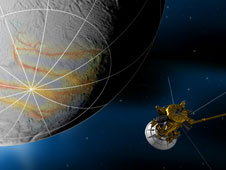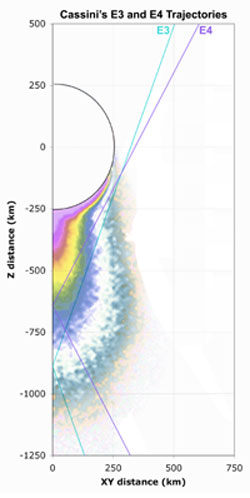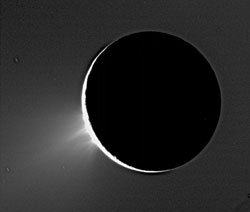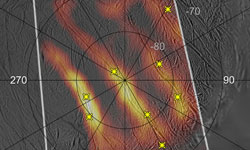
Amanda Hendrix
Cassini Scientist on the Ultraviolet Imaging Spectrograph (bio)
Hi everybody,
Well, after the successful and exciting Enceladus flyby in March … we’re doing it again!! Cassini is executing a close pass by the little active moon, on Monday, August 11. Woo hoo!
This is the 5th close Enceladus flyby we’ve done. The first was in February 2005 (that one was not an official “targeted” flyby), the 2nd was in March 2005, the 3rd was July 2005 and the 4th was in March 2008. This is the 4th targeted flyby, so it’s sometimes referred to as E4.
It’s super exciting, because we’ll pass just about 50 kilometers (30 miles) from the surface, and fly into the plume at the south pole. This is similar flyby geometry to the pass we did in March 2008 — but this time, the focus is on the imaging instruments. (Recall in the March flyby – E3 – the spacecraft was oriented to optimize measurements by the fields and particles instruments, especially the INMS-Ion and Neutral Mass Spectrometer–so they could “taste” the plume as we flew through.) This time, the spacecraft will be oriented to optimize imaging of the south polar region – to get the highest possible resolution images of those tiger stripes, the primary sources of the jets that feed the plume.
Here’s a little overview of what’s going to happen during the flyby, focusing on the remote sensing measurements. Have a look at the accompanying cool movie (put together by navigator extraordinaire and all around heckuva guy Brent Buffington). Some of it goes by pretty fast, so you might want to go through it a few times to absorb what’s happening. I’ll talk you through it.
At the beginning of the Enceladus segment, Enceladus is still pretty far away and small. We start with a long (6.5 hr) observation where ISS (the Imaging Subsystem – the movie shows the Narrow Angle Camera, or NAC, as a white box) is the “prime” instrument (but all the other cameras — ultraviolet, infrared, long-wave infrared – are taking data too). So ISS scans around, to sort of map out the environment of Enceladus and probe into any visible plume material around Enceladus. We then turn to Earth for a short (3 hr) downlink. We want the solid-state recorders (SSRs, where the data are stored until downlink) to be as empty as possible before we get closer to Enceladus and want to really fill them up with a lot of bits of good data. After the short downlink, we turn back to Enceladus and this time VIMS (the Visual and Infrared Mapping Spectrometer – with the field-of-view indicated by the red box) is the “prime” instrument. Enceladus is still small so we’re just staring and building up signal as we get closer and closer, to get good signal-to-noise spectra to understand the composition of Enceladus. By the end of the VIMS observation, Enceladus is just about fills the NAC. By the way, we’re coming in over the northern hemisphere of Enceladus; this is a relatively old part of the moon, which is apparent from the amount of craters present. Still not nearly as many craters as the Earth’s moon or Rhea, but it’s pretty heavily cratered for Enceladus. (The south polar region has *no* craters – since all that geologic activity wipes them out.) But I digress! So after VIMS, we switch to UVIS (the Ultraviolet Imaging Spectrograph) as “prime” instrument. This is the long, skinny pink/magenta field-of-view that you see in the movie. UVIS does a slow scan of the space near Enceladus by orienting the slit several radii off the body and slowly scanning onto the bright limb. If there are neutral gases such as hydrogen or oxygen in the vicinity of Enceladus (and we expect there to be, since we know there’s H2O vapor in the plumes), this is a possible way to detect those species and map them out. So after UVIS, ISS is prime again. And now we get into the really cool part.
ISS starts off with a two-panel mosaic of the northern hemisphere. Since the trajectory is pretty similar to the E3 trajectory, these images will be pretty similar to the ones obtained back in March – but still neat. Then the spacecraft does a large turn to get ready and oriented for closest approach. The flyby is so close and fast that it isn’t possible to make observations throughout the pass – we simply can’t keep up. The plan since the beginning was to orient the spacecraft, just prior to closest approach, so that the cameras will observe the active south pole region at the highest resolution possible. Notice in the movie that the spacecraft does the big turn, and then the boresights are actually pointed away from Enceladus for just a little while — so that as we zip by the moon, we’ll capture the south pole. So the imaging team (and I think Paul Helfenstein was primarily responsible) came up with this “skeet shoot” plan to execute 7 NAC frames across the tiger stripes, with resolutions between just 7 and 28 meters per pixel! Such high resolution images, combined with context frames, will really help in understanding the cracks and jets, and will provide clues to the origin of the plume. So the 7 frames are taken in under 3.5 min, and then 7 more are taken at resolutions up to 140 meters per pixel over the next 20 minutes or so. (The other instruments are “riding along” to get compositional and temperature information.) Note that the south pole is partly in darkness, and we’re moving fast, so the images and exposure times are carefully planned to balance light and smear. Images close to the terminator will really bring out the topography of the region, so they should be pretty spectacular.
After ISS is finished, CIRS takes over. CIRS is the Composite Infrared Mapping Spectrometer – the instrument that can “see in the dark” and map surface temperatures. CIRS becomes “prime” and does a few scans with their FP1 slit (the red circle) and their FP3 slits (the two little red rectangles). These observations will complement the *great* measurements made by CIRS on the last flyby in March (E3). Note that at about 21:41, Enceladus goes into Saturn eclipse – so there’ll be very little reflected solar light off Enceladus, which creates ideal conditions for measuring heat coming from within Enceladus. Enceladus comes out of eclipse at ~00:07. At ~01:06, or 4 hours after closest approach, VIMS is prime again for 1 hour, to get more compositional information on the south pole. We then turn to Earth for a 5 hour downlink. Then we turn back to Enceladus for a final stare with UVIS as prime instrument.
Recall that equinox is coming up in a year — Aug. 11, 2009 – and as we approach equinox (and solstice after that) the south pole is dominated more and more by darkness. So it’s really important that we get as many good looks at this wild south pole while we can! Of course, CIRS can do a lot of science even if the pole is in complete darkness – and later in the mission those will be important measurements to make, in case there is any seasonal input to the plume activity.
Whew! I’ve written a lot and hopefully haven’t bored you all completely to tears … I’m obviously very excited about this flyby and hope that you are too! Thanks for reading and coming along with us to explore Enceladus.
Amanda
 Todd Barber,
Todd Barber,  Speaking of propellant usage, there have been some questions about how
Speaking of propellant usage, there have been some questions about how 

 Todd Barber
Todd Barber 
 Carolyn Porco
Carolyn Porco 
 I will say what I said four years ago as we were first entering the Saturn system and about to begin our explorations of this mysterious and far-away place … a time that now seems like a lifetime ago: Prepare to be amazed!
I will say what I said four years ago as we were first entering the Saturn system and about to begin our explorations of this mysterious and far-away place … a time that now seems like a lifetime ago: Prepare to be amazed!